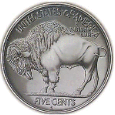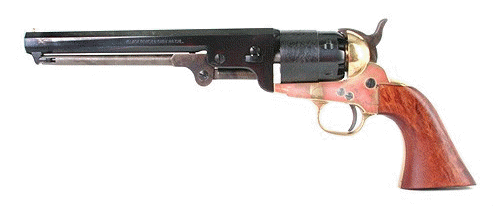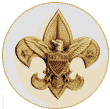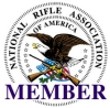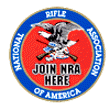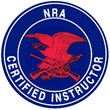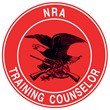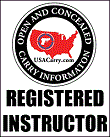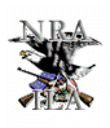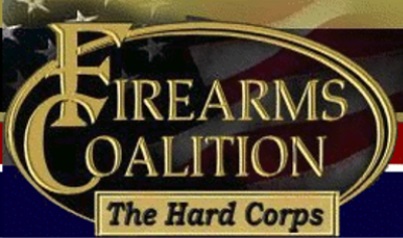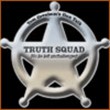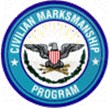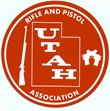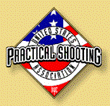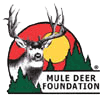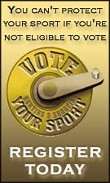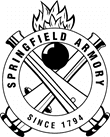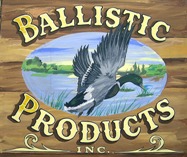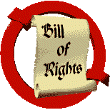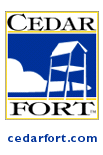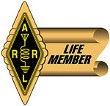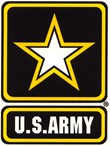|
Contrary to what one hears in the news media and the claims made by certain politicians and radical groups, shooting is one of the safest sports -- when practiced by persons of sound judgment in accordance with basic rules of safety. Muzzleloading is a safe and natural extension of that sport.
If any information in this document conflicts with information given in the manual or the instructions your received with your muzzleloading equipment and supplies, always follow those instructions -- not mine.
General safety:
-
Read the instruction manual for each piece of equipment you use. Keep it handy for later reference.
-
Understand what you are doing and why it must be done in a specific way.
-
Stay alert when muzzleloading. Don't shoot when distracted, disturbed or tired.
-
Never shoot when under the influence of alcohol or drugs (legal or illegal).
-
Never smoke while shooting or near combustibles and explosives.
-
Always wear safety glasses while shooting.
-
Place your ramrod in the barrel and mark the ramrod even with the muzzle. This can be used as a reference to ensure the gun is completely unloaded and has no obstruction in the bore.
-
Set up a loading and shooting procedure and follow it. Don't vary your sequence of operations.
-
Never
lean over or look directly into the muzzle. Minimize placing fingers and hands over the muzzle.
-
Keep everything locked up and out of the reach of small children.
-
Do not eat while handling lead.
-
Follow loading recommendations exactly.
-
Don't substitute components for those listed in your manual.
-
Start loading with the minimum powder charge given for your firearm. Generally, one grain of black powder for each caliber. Start with 54 grains of black powder in a 54 caliber rifle.
-
Never exceed manufacturers' loading data. Excess pressures caused by excessive loads could severely damage a firearm and cause serious injury or death.
Gunpowder Safety:
-
Modern ammunition uses smokeless powder to propel the bullet down the barrel. It burns with much greater energy and pressure than blackpowder. Therefore, never use smokeless powder in a firearm designed for blackpowder.
-
Specific powders are designed for specific uses. Don't use them for other purposes.
-
Never mix smokeless powder and blackpowder.
-
Never mix blackpowder and blackpowder substitute such as Pyrodex®.
-
Never mix different brands or types of powder.
-
Never use an unknown gunpowder.
-
Pour out only enough powder for the immediate work.
-
Use a single-charge-sized measure to pour each charge into your barrel. Never pour powder directly from a flask or canister into the bore. A spark in the bore will ignite the powder as you pour it in. The flash will very likely follow the stream of powder up the barrel and into your flask with deadly results.
-
Have only one kind of powder open and available for loading at a time.
-
Wash your hands thoroughly after handling powder.
-
Store powders only in original package. Don't repackage.
-
Keep powder containers tightly closed when not in use.
-
Clean up spilled powder with brush and dust pan; do not use a vacuum cleaner because fire or explosion may result.
-
Store powder in cool, dry place.
-
Store and keep caps and powder separately.
-
Powder is extremely flammable. Dispose of deteriorated powders according to recommendations in The Properties and Storage of Smokeless Powder SAAMI Reprint #376-2500, which is published in some handloading guides or available from NRMA.
Cap safety:
-
Don't ream out or enlarge the flash hole in your firearm. This can increase chamber pressure.
-
Keep caps in the original packaging until used. Don't store in your capping device. Return unused caps to the factory package. Don't dump together and store in bulk. There is a risk of mass detonation if one is ignited.
-
Open only one package of caps at a time.
-
Do not force caps. If you feel resistance to seating of a cap, stop and investigate.
-
Store caps in a cool, dry place. High temperature, such as in a summer attic, causes them to deteriorate.
-
Store and keep caps and powder separately.
-
Don't handle caps with oily or greasy hands. Oil contamination can affect ignitability.
-
Clean your capping device after each use. There have been instances of "primer dusting" in capping devices because of vibration.
Lead safety:
-
Lead is known to cause birth defects, reproductive harm and other serious physical injury, must be handled with extreme care.
-
Never eat, drink, or smoke when handling lead.
-
Handle lead bullets or lead shot only in a well ventilated area.
-
Always wash hands after handling lead and before eating.
-
Molten lead id hot -- 650-750 degrees Fahrenheit. This is no activity for children -- not even to watch!
-
The melting pot must have a steady base -- a lap full of hot lead would surely take all the fun out of casting and handloading.
-
Never discharge firearms in poorly ventilated areas.
Black powder supplies and accessories:
-
Black powder (a mechanical mixture of 75% potassium nitrate [salt peter], 10-11% sulfur and
14-15
% charcoal (by weight)) or a black powder substitute such as Pyrodex. For 50 caliber and larger use FFg or Pyrodex RS. For 45 caliber and smaller (including pistols) use FFFg or Pyrodex P. (Note: According to one source, the optimum proportions for gunpowder are: 74.64% potassium nitrate, 13.51% charcoal, and 11.85% sulfur (by weight).
-
Adjustable powder measure.
-
Powder flask or pour spout for the powder can to make it easier to pour powder into the powder measure.
-
Percussion caps (use what your owners manual suggests, usually #11 for rifles).
-
Patches. Round balls generally need patches (.010 to .015 inch thick cotton, dry or pre-lubed, pre-cut patches recommended).
-
Pure lead round balls (generally .010” smaller than your nominal bore diameter or as specified by your owners manual).
-
Conical bullets or sabot bullets.
-
Short starter.
-
Liquid patch lube (If not using pre-lubed patches).
-
Bore cleaning tips (jags) for your ramrod / cleaning rod.
-
Nipple removal tool.
-
1 x 1 foot square piece of carpet or similar cushioning material.
Rifle & pistol loading
-
Some guns are made with a slow rifling rate of twist designed to shoot round balls.
-
Guns designed to shoot conical bullet or sabots have a faster rate of twist. Conical bullets and sabots normally don't need patches.
-
Never start with a maximum load. Large loads will not be as accurate, produce more fouling, and will increase recoil. Watch for indications of excessive pressure.
-
Black powder burns differently from smokeless powders. You will probably notice it gives more of a “push” rather than a “kick” when you shoot. Stock design also affects the effects of recoil.
-
Start loading with the minimum powder charge given for your firearm. Generally, one grain of black powder for each caliber. Start with 54 grains of black powder in a 54 caliber rifle. Work up in small (3-5 grain) increments to no more than the maximum listed in the manual for your firearm until you find the most accurate load. One shooter found that, for him, the optimum powder charge for a round ball is approximately equal to ball diameter X 2 X rate of twist.
-
Minnie balls (allegedly named after the inventor, a French military captain) and other non-spherical projectiles normally don't use a patch. Apply a lube formulated for black powder shooting to the projectile before loading.
-
Soldiers, by and large, didn't use rifled muskets until after the invention of the Minnie bullet. Patched roundballs in a rifle take about five times longer to load than loose balls in a smoothbore musket. When the hollow-based Minnie came along and rifle-muskets could match smoothbore rates of fire. A Minnie bullet is sized initially to drop down the barrel fairly loosely. The expanding powder gasses inflate the skirt into the rifling, tightening it for the trip out. Minnies also have lube-filled grease rings around the skirt. This lube softens the fouling, causing the gun to be a bit closer to self-cleaning.
-
If shooting balls, use the tightest patch/ball combination possible for the type of shooting you are doing. Apply a lube formulated for black powder shooting to the patch. Check fired patches for signs of gasses blowing past the patch -- a sign of a too-loose fit.
-
Seating depth of the bullet or ball is extremely important for safety and consistent accuracy. Many shooters mark the ramrod to indicate the depth of a properly loaded charge.
-
If you cast your own bullets, remember their hardness, diameter and lubrication affect the ballistics as well as ease of loading. Softer (pure) lead is generally best.
-
New barrels seem to gradually improve in accuracy over time. Some rifles require up to 200 rounds to settle down.
-
Pay attention to the force required to seat a projectile. When the force required begins to increase, run a lubed patch though the bore to remove fouling buildup. Generally, I like to wipe the bore after every fifth shot. For optimum accuracy, wipe the bore after every shot.
-
Loose patch/ball combinations, bores with very deep rifling, high humidity, and high temperature tends to increase fouling and require more frequent cleaning between shots.
-
Arrange your shooting supplies on a waist high surface. It helps to have a surface with a notch cut into the edge to lean your gun barrel into to keep it from falling over while you work.
-
Cock the hammer to half-cock.
-
Place the carpet on the ground under the notch. Place the butt of your rifle on the carpet to protect the butt from damage.
-
Open the container of black powder or Pyrodex and pour the recommended amount of powder for your firearm into the adjustable powder measure. Re-cap the powder container.
-
Pour the powder into the muzzle of your rifle.
-
If shooting conical bullets or sabots, skip the steps dealing with patches.
-
If not using pre-lubricated patches, saturate a patch with patch lube and squeeze out any excess lube between you thumb and fingers. The patch should just be damp.
-
Center the patch over the muzzle and place a ball on top of the patch. The patch must completely wrap around the sides of the ball as it starts into the barrel. The patch grasps the ball so that the rifling can spin it and fills the rifling grooves providing a gas tight seal.
-
Use your short starter to force the projectile into the muzzle, striking the short starter sharply with your open hand until the ball is 4 to 6 inches into the barrel.
-
Insert the ramrod into the muzzle. Grasp your ramrod about 6 inches above the muzzle and push the ball down the barrel all the way to the powder charge. Move your hand progressively 6 inches up the rod until the ball is seated. This will help to keep you from breaking the ramrod.
-
Ensure the ball, bullet or sabot is seated firmly on the powder. An air space between the powder and the ball will cause dangerous overpressures.
-
Your projectile should push easily down the barrel but with some effort. If it takes a hammer to force the ball down the barrel try a thinner patch. If the ball slides down the barrel with little or no effort use a thicker patch.
-
Conical bullets and sabots may require extra force to start because you are forcing them into the rifling.
-
Once you are sure that you have properly seated the ball onto the powder, mark your ramrod at the muzzle of the barrel so you can reference the mark during future loading as an additional check that the ball is firmly seated.
-
Cap the nipple with one cap.
-
Bring the hammer to full cock.
-
Make sure that the butt is firmly against your shoulder.
-
Aim the target.
-
If you have two triggers, pull the rear trigger to set the forward trigger. Be careful, because a trigger that has been set is generally very sensitive. It's called the "hair trigger" for a reason.
-
Pull the trigger and convert that powder to energy and smoke.
-
If you pull the trigger and the cap snaps but the gun does not shoot, keep the barrel pointed downrange for 30 seconds. Re-cock the hammer, remove the old cap, replace it with a new cap and try again. If after 3 to 4 tries it still refuses to shoot, seek help from an experienced muzzleloader. Continue to consider the gun to be fully loaded and keep the muzzle pointed in a safe.
-
Ramming the ball / bullet will steadily become more difficult due to fouling. After 4 to 5 shots your bore probably is in need of swabbing. Swabbing softens and removes some of the crud from the rifling and will makes further loading easier. A water-wetted patch or two followed by a dry patch will suffice. Fouling pushed into the drum / snail by the swab can block ignition so be aware.
Prevent missing & double charges
Shooting sabots
-
Sabots are plastic cup-like adapters which allow shooting smaller-caliber bullets in larger bore firearms. This allows the hunter to take advantage of the
characteristic of modern hunting projectiles. For example, I shoot .45 caliber jacketed and cast pistol bullets in my .58 caliber Hawkin.
-
Insert the bullet into the sabot, base down and fully seated into the sabot.
-
After loading the desired powder charge, push the loaded sabot into the muzzle and seat firmly on the powder charge as for traditional bullets and balls. No lube or patch is required.
-
Cap and shoot.
-
As with shooting traditional projectiles, a fouled bore can make loading difficult and can cause erratic accuracy. Therefore, wipe the bore as needed (after each shot for best results) with a water or solvent wetted patch followed by a dry patch or two.
-
Except where noted, the following table shows typical ballistics of various .451 to .454 caliber bullets in a .58 caliber sabot manufactured by Muzzleload Magnum Products, RR 6, Harrison, AR 72601 (Warning: Do not exceed the recommendations of the manufacturer of your firearm!):
| 185-200 Grain Bullet in .58 Sabot
|
| Blackpowder
|
Pyrodex RS
|
| 80 g FF -
|
- 1480 fps
|
80 Equiv -
|
- 1390 fps
|
| 90 g FF -
|
- 1525 fps
|
90 Equiv -
|
- 1450 fps
|
| 100 g FF -
|
- 1575 fps
|
100 Equiv -
|
- 1460 fps
|
|
|
225-240 Grain Bullet in .58 Sabot
|
| Blackpowder
|
Pyrodex RS
|
| 80 g FF -
|
- 1400 fps
|
80 Equiv -
|
- 1375 fps
|
| 90 g FF -
|
- 1490 fps
|
90 Equiv -
|
- 1400 fps
|
| 100 g FF -
|
- 1575 fps
|
100 Equiv -
|
- 1450 fps
|
|
|
250-260 Grain Bullet in .58 Sabot
|
| Blackpowder
|
Pyrodex RS
|
| 80 g FF -
|
- 1340 fps
|
80 Equiv -
|
- 1330 fps
|
| 90 g FF -
|
- 1410 fps
|
90 Equiv -
|
- 1420 fps
|
| 100 g FF -
|
- 1490 fps
|
100 Equiv -
|
- 1500 fps
|
|
|
250 Grain Bullet in Unknown Sabot
American Hunter, Nov 2003, p 68
|
| Pyrodex RS
|
| 70 Equiv -
|
- 1672 fps
|
| 80 Equiv -
|
- 1744 fps
|
| 90 Equiv -
|
- 1819 fps
|
| 100 Equiv -
|
- 1868 fps
|
| 110 Equiv -
|
- 1910 fps
|
| 120 Equiv -
|
- 1934 fps
|
| 130 Equiv -
|
- 1962 fps
|
| 140 Equiv -
|
- 2056 fps
|
| 150 Equiv -
|
- 2101 fps
|
|
Accuracy tips
-
Shoot with a clean bore.
-
Keep the bore rust free. Oil can contaminate the powder, so use a rust inhibitor compatible with your powder.
-
For best accuracy, swab the bore with a moist patch between each shot. Many reenactment shooters take a brush to the bore between relays, which works out to 20-30 rounds.
-
Protect your scope from effects of smoke and particles escaping through the nipple.
-
Use a new nipple when accuracy is critical such as hunting or competition.
-
If your muzzleloader has a removable breechplug, remove the plug and clean from the breech end. This reduces cleaning rod wear to rifling at the muzzle. To make breechplug removal easier, coat the threads with an anti-seize product available in car parts stores.
-
Another option to protect rifling at the muzzle is to use a brass cleaning rod bore guide.
-
Use the hottest ignition system you can find.
-
Protect your rifle from the effects of weather by covering the muzzle and the cap with a single layer of self-cling plastic sandwich wrap secured with rubber bands. A single layer will not adversely affect ignition, accuracy, or safety.
-
Hunt with a fresh powder charge and cap.
Cleaning firearms
-
Due to the corrosive and fouling nature of black powder and black powder substitutes, clean your firearm promptly after each shooting session.
-
Disassemble the firearm.
-
Wash all metal parts with hot soapy water. The object is to remove all traces of fouling, ash, lube, etc. Ensure the entire bore is clean including the breach face.
-
Remove the nipple and ensure that no grease or oil is present in the “snail” or drum. Ensure that the nipple hole is clear. Clean these areas with alcohol. Carefully reinstall the nipple into the “snail” or drum from which it came, making sure you don’t cross thread it and that it is seated and tightened securely. Do not over-torque the nipple. A snug tight is fine.
-
Rinse thoroughly with hot clear water.
-
Dry thoroughly. Having used hot water to clean and rinse leave your barrel and other metal parts warm, expediting the drying process.
-
Thoroughly coat the bore with a lube formulated for blackpowder shooting.
-
Apply a thin film of gun oil or black powder lube on all metal parts to combat corrosion.
-
Clean wood parts with a light application of furniture polish or lemon oil.
-
Reassemble and store out of the reach of children and other unauthorized persons in a clean, dry place.
Return to Top
|
